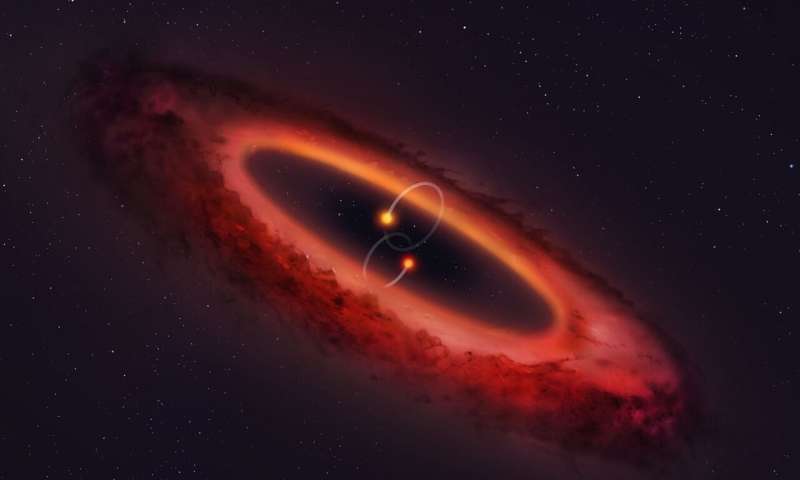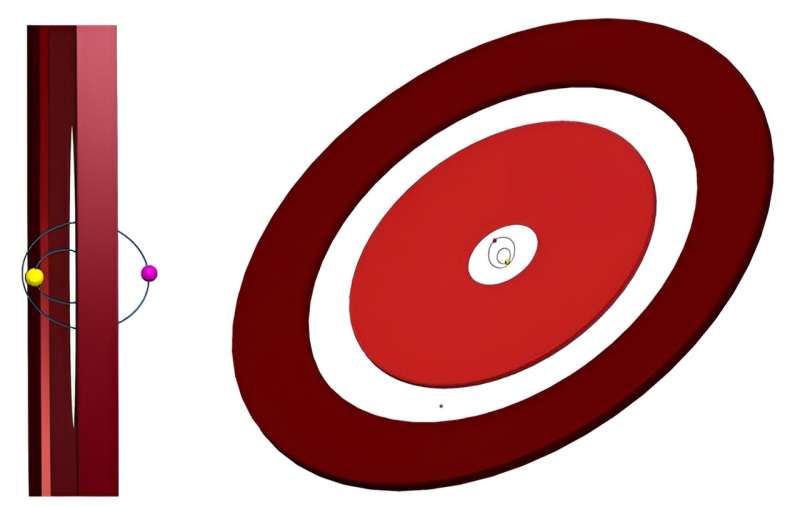This article has been reviewed according to Science X's editorial process and policies. Editors have highlighted the following attributes while ensuring the content's credibility:
fact-checked
preprint
trusted source
proofread
This is a first: An exoplanet in a polar circumbinary disk surrounding two stars

We live in an age of exoplanet discovery. One thing we've learned is not to be surprised by the kinds of exoplanets we keep discovering. We've discovered planets where it might rain glass or even iron, planets that are the rocky core remnants of gas giants stripped of their atmospheres, and drifting rogue planets untethered to any star.
Now, astronomers have uncovered evidence of an exoplanet in a circumbinary disk around a binary star. The remarkable thing about this discovery is that the disk is in a polar configuration. That means the exoplanet moves around its binary star in a circumpolar orbit, and this is the first one scientists have found.
AC Herculis (AC Her) is a binary star about 4,200 light-years away. The primary star is well-studied, while its partner is invisible. It has a polar circumbinary disk, which is unusual but not unheard of. In a new paper, a team of researchers presents evidence for the polar circumbinary exoplanet.
The paper is "AC Her: Evidence of the first polar circumbinary planet." It is published on the pre-print server arXiv. The lead author is Rebecca Martin from the Nevada Center for Astrophysics at the University of Nevada, Las Vegas.
"We examine the geometry of the post-asymptotic giant branch (AGB) star binary AC Her and its circumbinary disk. We show that the observations describe a binary orbit that is perpendicular to the disk," the authors write. The disk is close to a stable polar alignment, the authors explain, and the disk has a large inner radius. "The most likely explanation for the very large inner radius of the dust is a planet within the circumbinary disk."
The circumbinary disk has the telltale gap that signals the presence of a planet.
There's some uncertainty around the conclusion, and some of it stems from the size of the disk and the cavity the stars reside in in the center. In a circumpolar disk, there are different forces with different strengths at work that shape the stellar cavity. "The cavity size of a circumbinary gas disk depends upon the binary separation, the binary eccentricity and the inclination of the disk relative to the binary orbit," the researchers explain.
In a circumpolar arrangement, the cavity in the middle of the system where the stars reside should be small. "The size of the binary cavity is, therefore, an important diagnostic for the inclination of the disk relative to the binary orbit," they write. A disk in a polar orientation could extend down to 1.6 AU before the stellar cavity begins. That's a large dust cavity, and its size supports the existence of an exoplanet.

"The polar configuration of the disk in AC Her does not help to explain the large dust cavity since a polar-aligned disk has a smaller cavity size than a coplanar disk," Martin and her colleagues explain. "The best explanation remains the presence of a planet in the disk. Therefore, this is the first evidence of a polar circumbinary planet."
Planet formation in a disk is the same whether the disk is coplanar or circumpolar. But there's an additional factor in the AC Her system. The primary star is a post-AGB star, meaning it has already left the main sequence and passed through its red giant phase. During that phase, a star expands voluminously, tearing nearby planets to shreds and spelling their doom. So this planet could be a second-generation exoplanet, re-formed from the debris from the destroyed first-generation planets.
The circumbinary disk isn't exactly polar. A polar disk is inclined by 90° to the binary orbital plane, but this one is only off by 9%. "This is the first observed polar circumbinary disk around a post-AGB star," the authors write. The inner edge of the dust disk is further out than it should be, and this is another indication of an exoplanet.
It's important to note that this is not a main sequence star and that astronomers have never seen a polar circumbinary planet around non-main sequence stars. "Therefore, this is the first observational evidence of a polar circumbinary planet," the authors point out.
This planet is in the circumbinary disk, not in either of the circumstellar disks. The circumbinary disk actually feeds material into the circumstellar disks inside the stellar cavity, which can become fuel for more planet formation. But when a polar circumbinary disk feeds material into polar circumstellar disks, the arrangement may be unstable. Eventually, the polar circumstellar disk could become co-planar.
The AC Her system isn't the first binary star with a polar disk. The first one was announced in 2019 around the star HD 98800. (HD 98800 is actually a quadruple star containing a pair of binary stars.)
But as the first polar circumbinary disk to host a probable exoplanet, this unusual system begs to be studied more thoroughly. There's a lot we don't know about the planet, but that's not surprising. Even detecting one of these planets is extremely difficult.
The best evidence we have for it lies in the characteristics of the disk itself. But in this study, the team only identified the likely presence of a planet. We know nothing about its mass, radius, or anything else.
What type of planet is it? Does its formation in a polar circumbinary disk dictate its characteristics? What does its future hold?
Answers to those questions will have to wait.
More information: Rebecca G. Martin et al, AC Her: Evidence of the first polar circumbinary planet, arXiv (2023). DOI: 10.48550/arxiv.2310.19600
Journal information: arXiv
Provided by Universe Today





















